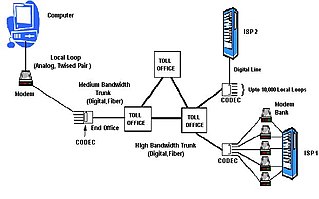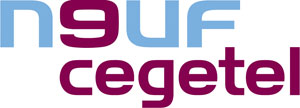Related Research Articles
Local loop unbundling is the regulatory process of allowing multiple telecommunications operators to use connections from the telephone exchange to the customer's premises. The physical wire connection between the local exchange and the customer is known as a "local loop", and is owned by the incumbent local exchange carrier. To increase competition, other providers are granted unbundled access.

In telephony, the local loop is the physical link or circuit that connects from the demarcation point of the customer premises to the edge of the common carrier or telecommunications service provider's network.

A digital subscriber line access multiplexer is a network device, often located in telephone exchanges, that connects multiple customer digital subscriber line (DSL) interfaces to a high-speed digital communications channel using multiplexing techniques. Its cable internet (DOCSIS) counterpart is the cable modem termination system.
Wireless local loop (WLL) is the use of a wireless communications link as the "last mile / first mile" connection for delivering plain old telephone service (POTS) or Internet access to telecommunications customers. Various types of WLL systems and technologies exist.
The last mile or last kilometer is a phrase widely used in the telecommunications, cable television and internet industries to refer to the final leg of the telecommunications networks that deliver telecommunication services to retail end-users (customers). More specifically, the last mile describes the portion of the telecommunications network chain that physically reaches the end-user's premises. Examples are the copper wire subscriber lines connecting landline telephones to the local telephone exchange; coaxial cable service drops carrying cable television signals from utility poles to subscribers' homes, and cell towers linking local cell phones to the cellular network. The word "mile" is used metaphorically; the length of the last mile link may be more or less than a mile. Because the last mile of a network to the user is conversely the first mile from the user's premises to the outside world when the user is sending data, the term first mile is also alternatively used.
A naked DSL, also known as standalone or dry loop DSL, is a digital subscriber line (DSL) without a PSTN service — or the associated dial tone. In other words, only a standalone DSL Internet service is provided on the local loop.

Telecommunications in Turkey provides information about television, radio, fixed and mobile telephones, and the Internet in Turkey.

In the field of telecommunications, the concept of triple play service refers to the provision of three essential services — high-speed broadband Internet access, television, and latency-sensitive telephone services — all delivered over a single broadband connection. This approach emphasizes the convergence of multiple services by a single supplier, aiming to enhance user convenience and streamline service delivery.
An open-access network (OAN) refers to a horizontally layered network architecture in telecommunications, and the business model that separates the physical access to the network from the delivery of services. In an OAN, the owner or manager of the network does not supply services for the network; these services must be supplied by separate retail service providers. There are two different open-access network models: the two- and three-layer models.
In telecommunications, cable Internet access, shortened to cable Internet, is a form of broadband internet access which uses the same infrastructure as cable television. Like digital subscriber line and fiber to the premises services, cable Internet access provides network edge connectivity from the Internet service provider to an end user. It is integrated into the cable television infrastructure analogously to DSL which uses the existing telephone network. Cable TV networks and telecommunications networks are the two predominant forms of residential Internet access. Recently, both have seen increased competition from fiber deployments, wireless, mobile networks and satellite internet access.

Fiber to the x or fiber in the loop is a generic term for any broadband network architecture using optical fiber to provide all or part of the local loop used for last mile telecommunications. As fiber optic cables are able to carry much more data than copper cables, especially over long distances, copper telephone networks built in the 20th century are being replaced by fiber.
In a hierarchical telecommunications network, the backhaul portion of the network comprises the intermediate links between the core network, or backbone network, and the small subnetworks at the edge of the network.
In the telephony business, sub-loop unbundling (SLU) is a type of unbundled access whereby a sub-section of the local loop is unbundled. In practice this often means the competitor placing a small street cabinet with a DSLAM, next to a telco local copper aggregation cabinet or serving area interface and using a "tie cable" to connect to the last part of the local loop into customers' homes. Lyddington in Rutland was the first example of SLU in the UK when local provider Rutland Telecom unbundled the cabinet to offer VDSL broadband.
Metallic path facility (MPF) are the unshielded twisted pair of copper wires that run from a main distribution frame (MDF) at a local telephone exchange to the customer. In this variant, both broadband and voice (baseband) services, together potentially with a video on demand service, are provided to the end user by a single communications provider. MPF services are typically delivered through use of an MSAN.

Neuf Cegetel was a French wireline telecommunications service provider and a mobile virtual network operator (MVNO). It offered various telecommunications services to consumers, enterprises and wholesale customers, ranking second in the country in annual revenues. It was legally established in 2005 following the completion of the merger between Neuf Telecom and Cegetel. As of June 2008, the company became a wholly owned subsidiary of SFR, and the brand disappeared commercially.
Unbundled access is an often practiced form of regulation during liberalization, where new entrants of the market (challengers) are offered access to facilities of the incumbent that are hard to duplicate. Its applications are mostly found in network-oriented industries and often concerns the last mile.
BT Wholesale and Ventures was a division of United Kingdom telecommunications company BT Group that provided voice, broadband, data, hosted communication, managed network and IT services to communications providers (CPs) in Great Britain. It was merged with BT's Business and Public Sector division to form BT Enterprise in October 2018.
Bit-stream access refers to the situation where a wireline incumbent installs a high-speed access link to the customer's premises and then makes this access link available to third parties, to enable them to provide high-speed services to customers. This type of access does not entail any third-party access to the copper pair in the local loop.
The prevalent means of connecting to the Internet in Germany is DSL, introduced by Deutsche Telekom in 1999. Other technologies such as Cable, FTTH and FTTB (fiber), Satellite, UMTS/HSDPA (mobile) and LTE are available as alternatives.

Broadband is a term normally considered to be synonymous with a high-speed connection to the internet. Suitability for certain applications, or technically a certain quality of service, is often assumed. For instance, low round trip delay would normally be assumed to be well under 150ms and suitable for Voice over IP, online gaming, financial trading especially arbitrage, virtual private networks and other latency-sensitive applications. This would rule out satellite Internet as inherently high-latency. In some applications, utility-grade reliability or security are often also assumed or defined as requirements. There is no single definition of broadband and official plans may refer to any or none of these criteria.
References
- ↑ "Network Costs Fact Sheet" (PDF). NTIA.